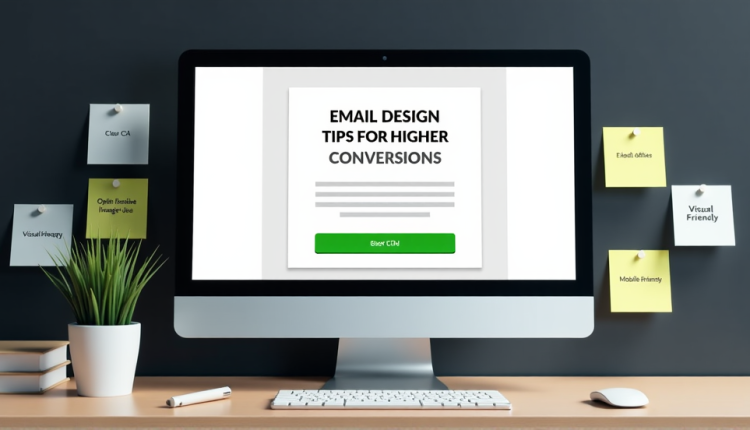
Email Design Tips For Higher Conversions
Email design is essential for grabbing attention and boosting conversions. A well-designed email guides readers naturally to your call-to-action (CTA). Mobile-friendly layouts ensure your emails look good on any device. Clear, bold CTAs encourage clicks and engagement. Clean, simple designs help make messages clear and easy to read. Small design changes can lead to big improvements in performance. Focusing on these tips will help you create emails that stand out and achieve better results.
1. Optimize for Mobile First
Most users open emails on their phones, making mobile optimization essential. Use a clean, simple layout to ensure readability. Fonts should be at least 14px, with large, clickable buttons for CTAs. Ensure that the main messages and the call-to-action are displayed without the need for scrolling.
Test emails on multiple devices to ensure a consistent experience. Avoid heavy images that have slow loading times. Mobile-friendly design helps your email stand out and keeps readers engaged.
2. Use Eye-Catching CTAs
A compelling call-to-action (CTA) is essential for boosting conversions. Enhance your call to action by employing eye-catching colors that attract attention. Select language that drives action, like “Buy Now” or “Join Free Today,” to create urgency.
Place your call-to-action in a prominent location, preferably above the fold, to ensure it is easily seen. Place it after a compelling message to motivate readers. Make sure the button is sufficiently sized for easy tapping, particularly on mobile devices.
Keep the number of CTAs in each email low to avoid confusing the reader. If necessary, add secondary CTAs, but make sure the main focus remains clear. Test different wording and placement for optimal results. An efficient call-to-action increases engagement and conversion rates.
3. Keep It Simple and Clean
A simple email design ensures clarity and better engagement. You can use a one-column layout for easy navigation. White space helps guide the reader’s attention and highlights key elements. Stick to one or two fonts that are clear and easy to read.
Use images sparingly and only if they support your message. Ensure each design element serves a specific purpose. A clean, uncluttered layout keeps your message focused and impactful.
4. Optimize Image Use
Images can enhance your email if used strategically. Optimize images to decrease file size and guarantee quicker loading times. Place images thoughtfully to guide readers to your key message or CTA. Use high-quality images that are clear and professional but under 1MB in size.
Add alt text for accessibility and to convey the message if images don’t load. Choose images that support your content, not just for decoration. Avoid overloading emails with too many images. Proper image use improves engagement without slowing performance.
5. Implement Visual Hierarchy
Visual hierarchy helps guide readers through your email effectively. Use larger, bold fonts for headlines to grab attention. Subheadings and smaller text can organize details clearly. Contrasting colors emphasize key elements like CTAs.
White space separates sections and reduces clutter positioning key content, such as benefits or CTAs, at the top. Use images to enhance the text and highlight the main message. Visual hierarchy helps readers and skimmers grasp essential points. A strong visual hierarchy ensures both readers and skimmers absorb your email’s key points.
6. Keep Key Content Above the Fold
The area visible without scrolling is prime real estate in your email. Place your most important message and CTA here to grab attention immediately. Highlight key benefits or offers to spark interest.
Use a clear, engaging headline that sets the tone. Ensure the design is simple and uncluttered for quick readability. Avoid placing excessive text or images that push vital content down.
Test on different devices to confirm visibility above the fold. Capturing attention early increases the chances of engagement.
7. Test and Refine
Regular testing ensures your emails remain effective. Utilize A/B testing to evaluate various designs, calls to action, or subject lines. Test emails on various devices to check compatibility and layout consistency.
Experiment with tone, style, and personalization to see what resonates. Gather feedback from team members or trusted users before sending. Analyze performance metrics like open and click-through rates to identify areas for improvement.
Make minor, data-informed adjustments to improve results. Continuous testing and refinement help maximize email engagement and conversions.
8. Additional Email Design Tips
- Sender Name: Use a personal or recognizable name.
- Subject Line: Keep it short and intriguing.
- Preheader: Add a short summary to support the subject line.
- Header: Combine images and text for a strong opening.
- Footer: Include contact details, social media, and an unsubscribe link.
- Personalization: Use dynamic content tailored to your audience.
- Layout: Balance text and images (60/40 rule).
- Colors: Stick to brand colors and use contrast for emphasis.
Conclusion
Email design is a powerful tool for boosting engagement and conversions. A clean, mobile-friendly design ensures accessibility for all users. Eye-catching CTAs drive readers to take action quickly. Optimized images enhance your message without slowing loading times.
Visual hierarchy helps guide attention to key points and CTAs. Keeping critical content above the fold captures interest immediately. Regular testing and refinement improve performance over time.
Utilize personalized approaches and straightforward communication to engage with your audience. With these strategies, your emails can stand out and deliver results.
FAQs
1. Why is mobile optimization important for email design?
Optimizing for mobile makes emails more readable and user-friendly on smartphones, which boosts engagement and conversion rates.
2. How do I make my call-to-action (CTA) more effective?
Utilize vivid color contrasts, and dynamic language, and position it prominently to enhance visibility and drive engagement.
3. How many images should I include in an email?
Limit images to avoid slow load times and focus on those that support your message.
4. What is the perfect length for email subject lines?
Keep subject lines under 7 words or 41 characters for clarity and engagement.
5. How often should I test my email designs?
Test regularly with A/B testing to refine design elements and improve performance.